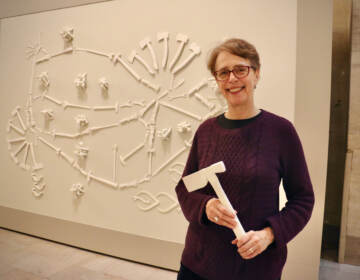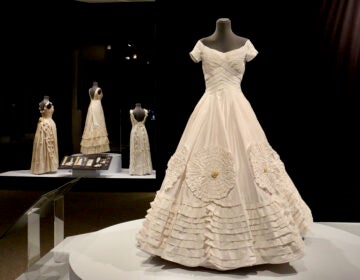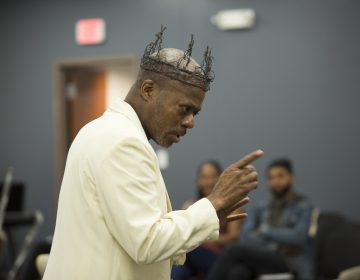Jackie Kennedy’s historic White House restoration re-created at Winterthur
The first lady's historic 1961 renovation of White House interiors, guided by Henry du Pont, is re-created at Delaware’s Winterthur museum.
Listen 1:50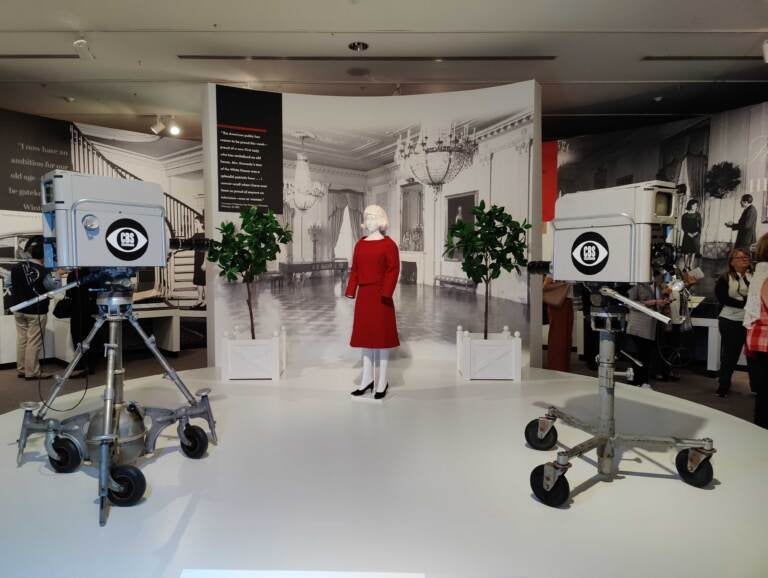
A mock-up of the CBS TV production inside the White House. The Jackie Kennedy mannequin is dressed in a re-creation of the red suit she wore for the TV house tour. (Peter Crimmins/WHYY)
Visitors to the galleries of Winterthur in Delaware are introduced to Jackie Kennedy’s White House the same way most Americans were introduced to it in 1962: through television.
The opening room of the new exhibition “Jacqueline Kennedy and H. F. du Pont: From Winterthur to the White House” is a mock-up of the CBS TV production set inside the White House that Kennedy had just redecorated.
At center, in front of the cameras, is a white mannequin of the first lady dressed in a re-creation of the suit she wore to take viewers on a tour of the house. Americans watching the black and white TV tour at the time would have never known her suit was a deep red color.
Despite being somewhat stiff and awkward — Kennedy affected a breathy speaking style and performed some unnatural camera blocking — the resulting show, “A Tour of the White House with Mrs. John F. Kennedy,” was seen on all three networks of the time and became one of the most-watched single television shows ever.
Eighty million people — mostly women — watched Kennedy’s house tour in 1962. By comparison: the most-watched documentary on Netflix, “Our Planet,” had 33 million viewers in its first month in 2019; the first run of Ken Burns’ Civil War miniseries in 1990 had about 40 million viewers; a typical Super Bowl has about 100 million viewers.
“Its impact really cannot be underestimated,” said curator Elaine Rice Bachmann. “It legitimized what she was doing. I don’t think anyone questioned that this was just a first lady redecorating the White House. She really put it in the context of: This was something the whole nation could be proud of. They were leaving a legacy that would be important for generations to come.”
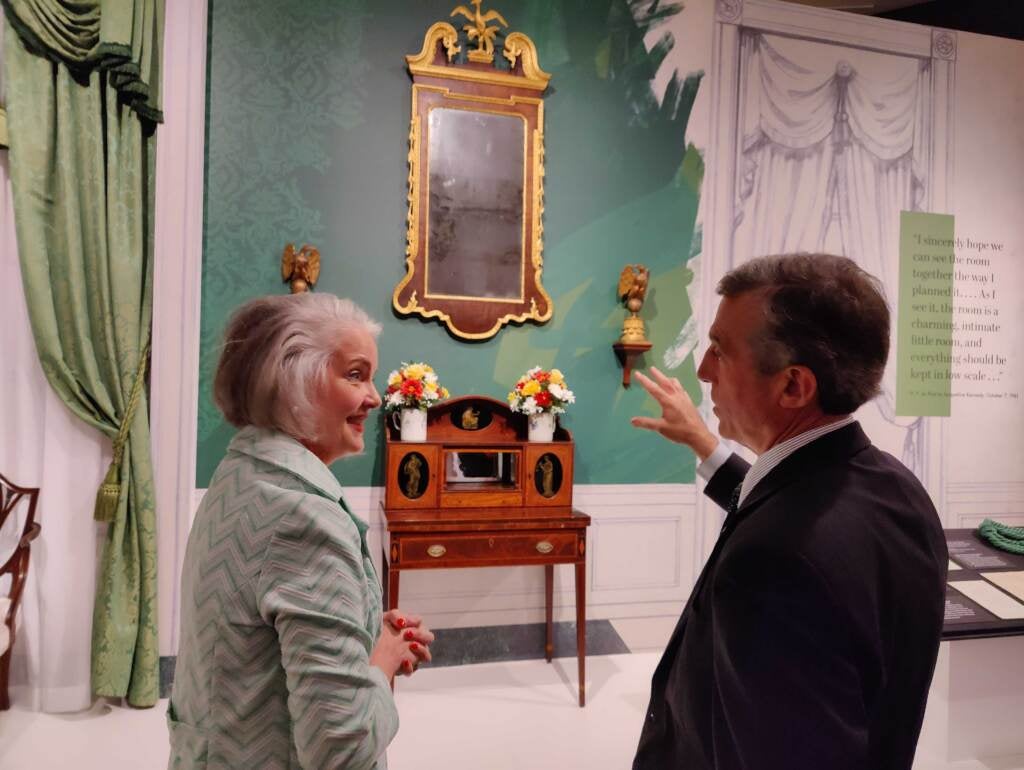
Bachmann, who wrote a book about Kennedy’s transformation of the White House, said the future first lady initially felt disappointed by the White House as an 11-year-old girl visiting with her mother. When she moved in after her husband’s Presidential inauguration in 1961, it had not improved much.
“The rooms that she was walking into were really filled with department store-type furnishings, and historical odds and ends,” Bachmann said. “Nothing cohesive in terms of the story of the House.”
The problem was that every presidential administration made its own, sometimes inconsistent decisions as to how to furnish the White House. As a result, it became a jumble of styles that made no sense, and did little to reflect the history of the house or the country it represents.
Departing presidents would sometimes simply take what they wanted and leave behind what they did not. Harry Truman, for example, took an original carved mantelpiece. He refused Kennedy’s request that it be returned, so she had to have a copy of it made and installed.
Kennedy formed a fine arts committee to help her turn the White House into something that could tell its own history. The chair of that committee was Henry Francis du Pont, the country’s preeminent collector of American decorative arts who in 1951 had turned his 175-room Delaware home into the Winterthur museum. Winterthur is now a renowned showcase, research, and conservation center for historical furniture and decorative arts.
“He really was the only person who had the gravitas and the experience,” Bachmann said. “In addition, he was a very avowed Republican, so it showed that it was a bipartisan project.”
Kennedy also created the White House Historical Association, a nonprofit committed to raising money for the upkeep of the house. It still exists to this day.
The exhibition at Winterthur features re-creations of some iconic rooms of the White House, including the Red, Blue, and Green rooms, formal reception rooms that had been color-coordinated since the first occupants of the house.
Kennedy had described the rooms as “hard” — too much red, blue, and green to be comfortable — calling the Green Room in particular a “dentist’s office bomb shelter.”
She softened the rooms by adding a pinkish cerise color to the red room, and recoloring the walls of the blue room with white-on-white wallpaper accented with blue trim and drapery. At the time that kind of French styling was considered controversial for the White House.
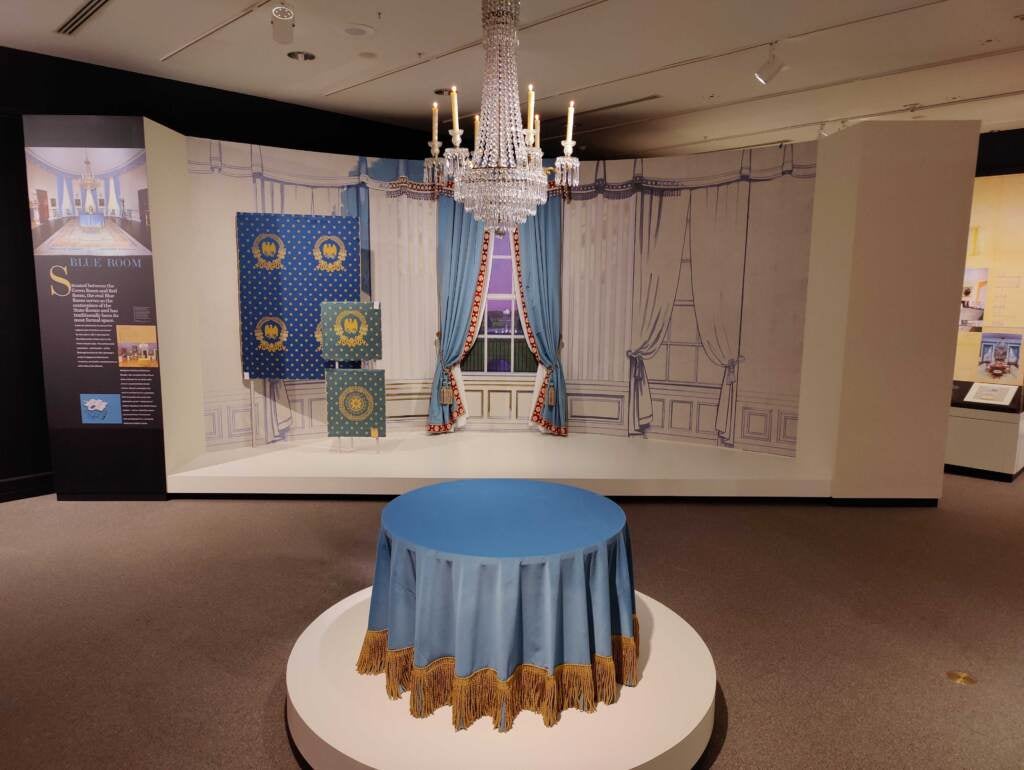
On the advice of du Pont’s and the committee, Kennedy either bought or borrowed appropriate furnishings. The recreation of the Red Room features the original sideboard Kennedy had borrowed from the Philadelphia Museum of Art in 1961. The PMA has loaned it out again, to Winterthur, for this exhibition.
In addition to re-creations of some White House rooms, the exhibition traces the back-room dealings and consensus-building Kennedy and du Pont undertook. As part of the project, Kennedy successfully pushed Congress to pass Public Law 87-286, which created a White House conservatorship, so that significant furnishings acquired during any future administration would be held in perpetuity by the White House, conserved at the Smithsonian Institute.
But du Pont and Kennedy did not always see eye-to-eye. Du Pont was strongly in favor of American decorative arts in the Federal style, while Kennedy, who had studied abroad at the Sorbonne in Paris, preferred the French Empire style.
“They got into some interesting arguments,” Bachmann said. “They’re all played out very diplomatically and very civilly in their correspondence.”
Compromises were made. Kennedy once relented to du Pont’s demands, saying, “As long as it has an eagle, it doesn’t matter if it’s French.”

The exhibition also features Kennedy as an entrepreneur. The redecorating budget she had been allotted fell far short of the ambitions of the project. To pay for the new interiors she proposed creating a souvenir guidebook that would be sold to White House visitors for one dollar.
Bachmann said President Kennedy was against it, believing it would be tacky to sell souvenirs out of the White House. But Mrs. Kennedy persisted. Within its first several months, “The White House: an Historic Guide” sold 600,000 copies, generating much of the $2 million needed for her renovations.
That guidebook has remained in print since then, updated by each administration.
“From Winterthur to the White House” will be on view until Jan. 8, 2023.
WHYY is your source for fact-based, in-depth journalism and information. As a nonprofit organization, we rely on financial support from readers like you. Please give today.




